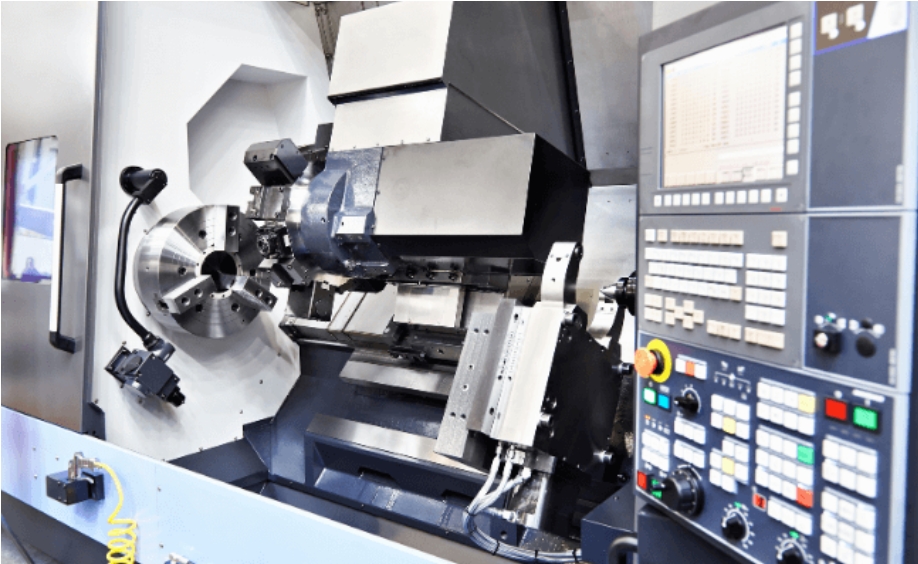
A CNC turning machine in operation, showing a metal rod being rotated while a cutting tool shapes it into the desired form.
Selecting the proper machining process is essential for the success of any manufacturing project. CNC turning and CNC milling are two widely used techniques, each offering unique benefits and suited to different applications. CNC turning involves rotating the workpiece while a stationary cutting tool shapes it, making it ideal for cylindrical parts like shafts and bolts.
On the other hand, CNC milling uses a rotating cutting tool to remove material from a stationary or moving workpiece, perfect for creating complex shapes and intricate details. Understanding these differences can help you choose the most suitable method for your needs, ensuring excellent performance, precision, and efficiency in your projects.
What is CNC Turning?
CNC turning is a machining process that involves rotating a workpiece while a stationary cutting tool removes material to shape it. This technique is commonly used to create cylindrical parts, such as shafts, bolts, and fasteners. The primary motion in CNC turning is the rotation of the workpiece, which is held in a chuck and spun at high speeds.
The cutting tool is controlled by a computer program to remove material and achieve the desired dimensions and surface finish. CNC turning is known for its precision and efficiency, making it ideal for producing parts with tight tolerances and smooth finishes. This process is highly automated, reducing the need for manual intervention and ensuring consistent quality across multiple parts.
CNC turning is suitable for various materials, including metals, plastics, and composites. It is widely used in the automotive, aerospace, and medical device manufacturing industries.
How Does CNC Turning Work?
Several cylindrical metal parts produced by a CNC turning machine
CNC turning is a precise machining process that involves several key steps. First, the workpiece is securely mounted in a chuck, part of the lathe. The chuck holds and spins the workpiece at high speeds. A computer-controlled cutting tool, typically made of carbide or other rigid materials, is programmed to move along specified paths to remove material from the workpiece. The cutting tool can move in multiple directions, including longitudinally along the axis of the workpiece and radially towards the center.
The process starts with rough turning, where the bulk of the material is removed quickly. This is followed by fine turning, where the cutting tool makes smaller, more precise cuts to achieve the desired dimensions and surface finish. The CNC program controls all movements and parameters, such as cutting speed, feed rate, and depth of cut, ensuring high precision and repeatability. Advanced CNC lathes may also include features like live tooling, which allows for additional machining operations such as drilling or milling, further enhancing the versatility of CNC turning.
What is CNC Milling?
CNC milling is a machining process that uses rotary cutters to remove material from a workpiece. Unlike CNC turning, where the workpiece rotates, in CNC milling, the cutting tool rotates while the workpiece remains stationary or moves along the milling table. This highly versatile technique can produce many complex shapes, including flat surfaces, slots, holes, and intricate 3D contours. CNC milling machines have a multi-axis system, typically three to five axes, allowing for precise and intricate machining.
CNC milling is widely used in various industries, including aerospace, automotive, and electronics, due to its ability to handle diverse materials such as metals, plastics, and composites. The process is controlled by computer programs that dictate the movement of the cutting tools, ensuring high precision and repeatability.
How Does CNC Milling Work?
Close-up view of a CNC milling machine, with a rotating cutting tool working on a stationary block of metal to create intricate designs.
CNC milling involves several key steps to transform a raw material into a finished part. First, the part’s computer-aided design (CAD) model is created. This model is then converted into a computer-aided manufacturing (CAM) program that generates the G-code, a set of instructions that control the CNC milling machine’s movements and operations.
The workpiece is secured onto the milling table, and the cutting tool, mounted on a rotating spindle, is set in motion. The CNC program directs the tool’s movements along multiple axes to remove material and shape the workpiece according to the design specifications. To create intricate features, the cutting tool can move horizontally, vertically, and even in complex paths.
The milling process typically involves several passes, starting with rough milling to quickly remove large amounts of material, followed by finishing passes that achieve the desired dimensions and surface finish. CNC milling machines can perform a wide range of operations, including drilling, tapping, and contouring, which enhances their versatility.
Advanced CNC milling machines may also feature automatic tool changers, allowing seamless transitions between different cutting tools and reducing setup time. The high precision and automation capabilities of CNC milling make it an essential process for efficiently producing high-quality, complex parts.
Advantages and Disadvantages of CNC Turning
Advantages
- High Precision and Consistency
CNC turning machines can produce parts with tight tolerances and excellent repeatability, ensuring each part meets specifications.
- Efficiency and Speed
The automated nature of CNC turning allows for rapid parts production, reducing lead times and increasing productivity.
- Ideal for Cylindrical Parts
CNC turning is particularly efficient for producing round or cylindrical parts such as shafts, bolts, and fasteners.
- Reduced Manual Labor
Automation minimizes the need for manual intervention, reducing labor costs and the potential for human error.
Disadvantages
- Initial Setup Cost
CNC turning machines can be expensive to purchase and set up, requiring a significant initial investment.
- Complex Programming
Developing CNC programs can be complex and time-consuming, requiring skilled operators and programmers.
- Material Waste
Turning processes often generate significant waste material, especially during rough turning.
- Size Limitations
CNC turning is best suited for cylindrical parts and may not be ideal for large or irregularly shaped workpieces.
Advantages and Disadvantages of CNC Milling
Advantages
- Complex Geometries
CNC milling excels at producing complex shapes and detailed features that are difficult to achieve with other machining processes. This capability is ideal for intricate aerospace, automotive, and medical components.
- Surface Finish
Milling can achieve a high-quality surface finish, crucial for parts requiring smooth surfaces and precise dimensions. This is particularly beneficial for aesthetic and functional components.
- Flexible Tooling
CNC milling machines can use various cutting tools, allowing for versatility in machining different materials and achieving various cutting actions, such as drilling, tapping, and contouring.
- Batch Production
Milling is well-suited for small and large batch production, making prototyping and mass production runs efficient.
Disadvantages
- Tool Wear and Replacement
The cutting tools used in milling are subject to wear and need regular replacement, which can increase operating costs and downtime.
- Initial Setup Time
Setting up CNC milling machines for new jobs can be time-consuming, especially when dealing with complex parts that require precise fixturing and alignment.
- Material Removal
Milling is a subtractive process, meaning significant amounts of material are removed to achieve the final shape. This can lead to higher material waste compared to additive manufacturing methods.
- Programming Complexity
Developing CNC programs for milling operations can be complex and requires skilled operators, especially for multi-axis machining, which can add to labor costs and training requirements.
Comparison Between CNC Turning and CNC Milling
Choosing the right machining process for your project is crucial, and understanding the differences between CNC turning vs milling can help you make an informed decision. Here’s a detailed comparison based on several factors:
1. Basic Process
- CNC Turning: The workpiece rotates while a stationary cutting tool removes material. This process is primarily used to create cylindrical shapes.
- CNC Milling: The cutting tool rotates while the workpiece remains stationary or moves along the milling table. This process can create various shapes, including flat surfaces, slots, and complex contours.
2. Typical Applications
- CNC Turning is ideal for producing round parts such as shafts, bolts, and fasteners. It is widely used in automotive, aerospace, and medical device manufacturing industries.
- CNC Milling is suitable for creating intricate parts with complex geometries, such as engine components, molds, and custom machinery parts. It is commonly used in aerospace, electronics, and construction.
3. Material Compatibility
- CNC Turning is effective with various materials, including metals (e.g., steel, aluminum, brass) and plastics, especially cylindrical parts.
- CNC Milling is versatile across various materials, such as metals (e.g., aluminum, steel, titanium), plastics, and composites, and it is suitable for both simple and complex shapes.
4. Precision and Surface Finish
- CNC Turning: Provides high precision and excellent surface finishes on cylindrical parts, making it suitable for components requiring tight tolerances and smooth surfaces.
- CNC Milling offers high precision and can produce detailed and intricate surface finishes on complex parts. It is ideal for components needing fine details and high-quality finishes.
5. Production Speed and Efficiency
- CNC Turning is generally faster for producing cylindrical parts, particularly high-volume production. Automation reduces manual labor and enhances efficiency.
- CNC Milling efficiently produces complex shapes and detailed features, although setup times can be longer. It is suitable for both prototyping and batch production.
6. Tooling and Flexibility
- CNC Turning: Utilizes fixed cutting tools optimized for shaping round parts. Less flexible for non-cylindrical parts.
- CNC Milling employs various cutting tools and can perform multiple operations, such as drilling, tapping, and contouring, offering greater flexibility for different shapes and sizes.
7. Cost Considerations
- CNC Turning: Typically has lower setup costs for cylindrical parts but can generate more material waste. The initial investment in machinery can be high.
- CNC Milling: Higher initial setup costs due to complex programming and tooling, but offers greater versatility. Material waste can be significant depending on the complexity of the part.
A table summarizing the differences between CNC milling vs turning
| Features | CNC Turning | CNC Milling |
| Basic Process | Rotates the workpiece; stationary cutting tool shapes it | Rotates the cutting tool, the workpiece remains stationary or moves |
| Applications | Cylindrical parts (shafts, bolts, fasteners) | Complex shapes, flat surfaces, slots, holes |
| Material Compatibility | Metals (steel, aluminum, brass), plastics | Metals (aluminum, steel, titanium), plastics, composites |
| Precision | High precision for cylindrical parts, smooth finishes | High precision for complex geometries, intricate details |
| Production Speed | Faster for cylindrical parts, high-volume production | Efficient for complex shapes, suitable for prototyping and batch production |
| Tooling | Fixed cutting tools for round parts | Variety of cutting tools, multiple operations (drilling, tapping, contouring) |
| Cost | Lower setup costs, potential material waste | Higher setup costs, greater versatility |
Conclusion
CNC turning and CNC milling offer distinct advantages and are suited for different projects. CNC turning excels in producing precise cylindrical parts quickly, while CNC milling provides versatility in creating complex geometries and detailed features. By understanding their unique properties, you can make an informed decision that best meets your manufacturing requirements. If you need expert advice in choosing the best for your manufacturing project, partnering with top-notch CNC machining companies like Zintilon is a great decision.


